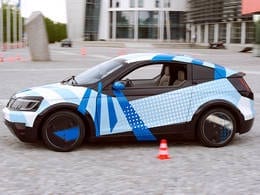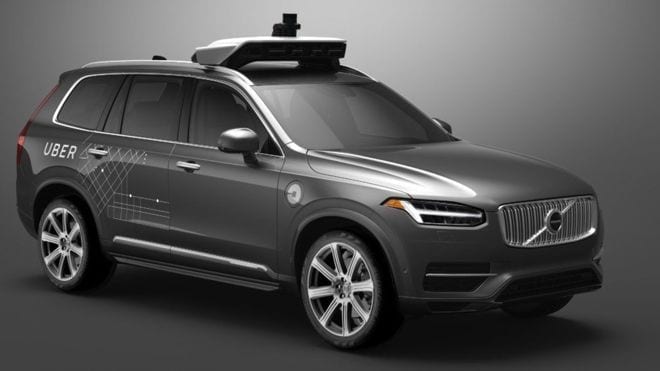Fully autonomous cars may still be the stuff of science fiction. Remote driving technology, however, may be much closer than we think.
Scientists at the Technische Universität München (TUM) believe that full-size remote control cars could be hitting the roads within the next five to ten years. So if your next rental car turns up to your door driverless, the chances are that the actual driver is sitting in the car rental headquarters.
Researchers at TUM’s Institute of Automotive Technology have demonstrated that cars can be driven remotely and safely on public roads. As part of their project, the engineers equipped the Visio.M electric car with six video cameras and enabled all functions to be activated via a central control panel. The video images are fed into a computer before being encoded and sent to the driver at the remote operator station via LTE.
The station resembles a driving simulator, equipped with a steering wheel, instrumentation panel and pedals. The operator views the road on three huge monitors that display images from up to five cameras facing to the front and to the sides. The cameras are positioned in the middle of the windscreen behind the rear view mirror. Another camera relays images from behind the car.
The force feedback steering wheel uses actuators to simulate driving forces and thus delivers an extremely realistic driving experience. The brakes are equally realistic – the pedal in the operator station reacts in the exact same way as the pedal in a car. In addition to the 360-degree view of the car’s environment, the operator can also hear exactly what is going on inside the car thanks to Dolby 5.1 technology.
In many cities today, the LTE network has sufficient reach to deliver the bandwidth required to transmit video images, sound and control data from a car. In addition, mobile networks are continuing to expand. These increases in capacity are flanked by the emergence of the next video coding standard, H.265, which can compress images even more efficiently to just fifty percent of the sizes currently possible today. Even without these developments, the data could still be transmitted today via the much slower UMTS network as the delay here is well under half a second.
In the event of a bandwidth bottleneck or a sudden connection failure, the vehicle automatically brakes until it reaches a standstill. Despite the technical feasibility, however, there are still a number of legal hurdles to be overcome before this technology can be deployed on regular roads.
The Latest Bing News on:
Autonomous cars
- In the first Autonomous Racing League race, the struggle was realon April 27, 2024 at 7:28 pm
Instead, they declared things like that these cars are “pushing the boundaries of science.” When it came time for the actual race, the lead racer, Polimove, spun out on the fourth of eight laps. The ...
- Tornadoes flatten homes in Nebraska as storms threaten parts of the Midweston April 27, 2024 at 10:10 am
Elkhorn, a town less than 10 miles from Omaha, sustained some of the most severe damage with many homes flattened. Two people were taken to the hospital with minor injuries. Other areas like Waterloo ...
- Reflecting on AUVSI Xponential 2024: Key Insights and Future Directions in Autonomous Vehicle Technologyon April 26, 2024 at 11:13 am
Key Takeaways from Xponential 2024 by DRONELIFE Contributing Editor Paul Rossi As AUVSI Xponential 2024 wraps up in San Diego, the horizon for autonomous vehicle technologies across air, land, and s ...
- Abu Dhabi's driverless racing event will boost autonomous car safety, says experton April 26, 2024 at 2:01 am
One of the main goals of a new self-driving race car league in Abu Dhabi is to help reduce the number of road accidents around the globe, said a senior figure. On Saturday, teams from across the world ...
- Bills aimed at closing traffic ticket loophole for driverless cars get initial green lighton April 25, 2024 at 3:30 pm
A pair of bills that aim, in part, to close a loophole prohibiting autonomous vehicles from getting traffic tickets cleared major hurdles in the California legislature this week.
- Mercedes Is Selling Level 3 Autonomous Cars To US Consumerson April 25, 2024 at 10:00 am
Thanks to a new report, everyone has learned that Mercedes-Benz has started selling SAE Level 3 autonomous cars to consumers in the United States. While the numbers of those vehicles are apparently ...
- We should not make the same mistake with autonomous driving as we did with electric vehicleson April 25, 2024 at 9:04 am
Let's propel the automotive industry into a future where autonomy is not just a possibility but a reality, Henrik Green writes.
- Musk Says Robotaxi and Autonomous Vehicles are Tesla’s Futureon April 24, 2024 at 1:55 am
Tesla Inc. announced its first quarter earnings for 2024, with the company losing its position as the world's top EV manufacturer to the Chinese giant BYD in ...
- Tesla extends its gain after Elon Musk says robotaxi fleet could make non-autonomous cars obsoleteon April 23, 2024 at 3:02 pm
Despite a drop in revenue and other key metrics, Tesla's commitment to a more affordable model and new autonomous technology has investors optimistic.
- Mercedes Is First Automaker to Sell Level 3 Autonomous Vehicles in the USon April 23, 2024 at 1:09 pm
After securing permission to sell cars with advanced autonomous features in California and Nevada last year, Mercedes Drive Pilot vehicles are on the road, with some restrictions.
The Latest Google Headlines on:
Autonomous cars
[google_news title=”” keyword=”autonomous cars” num_posts=”10″ blurb_length=”0″ show_thumb=”left”]
The Latest Bing News on:
Self driving vehicles
- An AI star seeks to bring self-driving cars to Japan by 2030on April 27, 2024 at 7:00 pm
Yamamoto sees opportunity in Japan’s shortage of key autonomous driving technologies and co-founded Turing in 2021 with Chief Technology Officer Shunsuke Aoki to fill that gap. Their team developed ...
- Billionaire investor Ron Baron gets a first-hand demonstration of Tesla’s self-driving tech: ‘I want to see Steve Jobs’ house’on April 27, 2024 at 11:10 am
The billionaire investor told CNBC on Thursday that he was visiting Elon Musk's SpaceX near Los Angeles on Monday morning, meeting with engineers and finance staff. Then in the afternoon, he traveled ...
- 'You'll Be Amazed:' Elon Musk Urges Tesla Drivers To Try Supervised Full Self-Driving Softwareon April 27, 2024 at 2:03 am
Full Self-driving or FSD refers to Tesla’s driver assistance software which the company says will enable autonomous driving in due time. It currently requires active driver supervision but is expected ...
- Tesla’s Autopilot and Full Self-Driving linked to hundreds of crashes, dozens of deathson April 26, 2024 at 11:15 am
In total, NHTSA investigated 956 crashes, starting in January 2018 and extending all the way until August 2023. Of those crashes, some of which involved other vehicles striking th ...
- Young pedestrians, self-driving vehicles: What’s the safest scenario for crossing the road?on April 26, 2024 at 10:05 am
Crossing roads for children can be a risky calculation, especially when the vehicles are self-driven. In a new study, University of Iowa researchers determined pre-teenage children are safest when sel ...
- 1st self-driving car that 'lets you take your eyes off the road' goes on sale in the US — and it's not a Teslaon April 25, 2024 at 8:00 am
Mercedes-Benz has sold at least one of its new vehicles fitted with its Drive Pilot autonomous driving software, which lets you take your hands off the steering wheel and your eyes off the road.
- Some Mercedes Self-Driving Cars Won't Require You to Even Watch the Roadon April 24, 2024 at 12:05 pm
The cars are only available in California and Nevada and will only autonomously drive under certain circumstances.
- Tesla Cuts Prices on Cars and Self-Driving Systemson April 22, 2024 at 9:28 am
The company cut the prices of the Model Y, a small SUV which is Tesla's most popular model and the top-selling electric vehicle in the U.S., and also of the Models X and S, its older and more ...
- NVIDIA’s Blackwell chips could be the future of autonomous self driving vehicleson April 18, 2024 at 1:28 am
Learn more about how NVIDIA's latest chips are being used to help push forward the development of autonomous self driving vehicles. Blackwell ...
- Is Your Tesla Self-Driving Car Narcing You Out?on April 17, 2024 at 7:27 am
A viral video from The Ramcharitar Law Firm claims that Tesla could be sharing camera data with the NYPD and other police departments across the country.
The Latest Google Headlines on:
Self driving vehicles
[google_news title=”” keyword=”self driving vehicles” num_posts=”10″ blurb_length=”0″ show_thumb=”left”]












